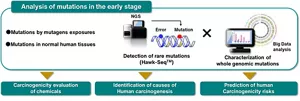Prediction of Carcinogenicity Using Whole-genome Mutation Analysis
Genotoxicity and Carcinogenicity
One in two people will be diagnosed with cancer in Japan and one in three become mortality cases, thus overcoming this disease has become a major social issue. It is extremely important to thoroughly confirm the carcinogenicity of raw materials in order to deliver safe and secure products to consumers. Accumulation of mutations in normal genomic DNA and abnormal functioning of genes (oncogenes, etc.) are known to cause cancer. However, rare genomic mutations in normal pre-cancerous tissues and those that occur immediately after exposure to chemicals are extremely difficult to analyze, thus much of the DNA mutation accumulation process has yet to be elucidated. Kao has focused on this issue and developed a new technology (Hawk-Seq™) that enables analysis of rare genomic mutations using a next-generation sequencer (NGS).
With this technology, it is possible to comprehensively detect rare mutations in the entire human genome. By revealing the characteristics of genomic mutations from large-scale data (big data) and visualizing the accumulation process, it is possible to not only predict the carcinogenicity of chemicals with high accuracy, but also understand the causes of human carcinogenesis. Also, it is expected to make possible prediction of cancer onset.
In the future, based on scientific knowledge, Kao will deliver safe and secure products to consumers around the world, collaborating with domestic and overseas research institutes. Furthermore, we intend to utilize this technology in diagnostic and drug discovery fields, such as for early diagnosis of cancer, and development of therapeutic and preventive drugs.


- Home
- Innovation
- Research & Development
- Fundamental Research
- Safety Science
- Prediction of Carcinogenicity Using Whole-genome Mutation Analysis
- Home
- Innovation
- Research & Development
- Fundamental Research
- Safety Science
- Prediction of Carcinogenicity Using Whole-genome Mutation Analysis
